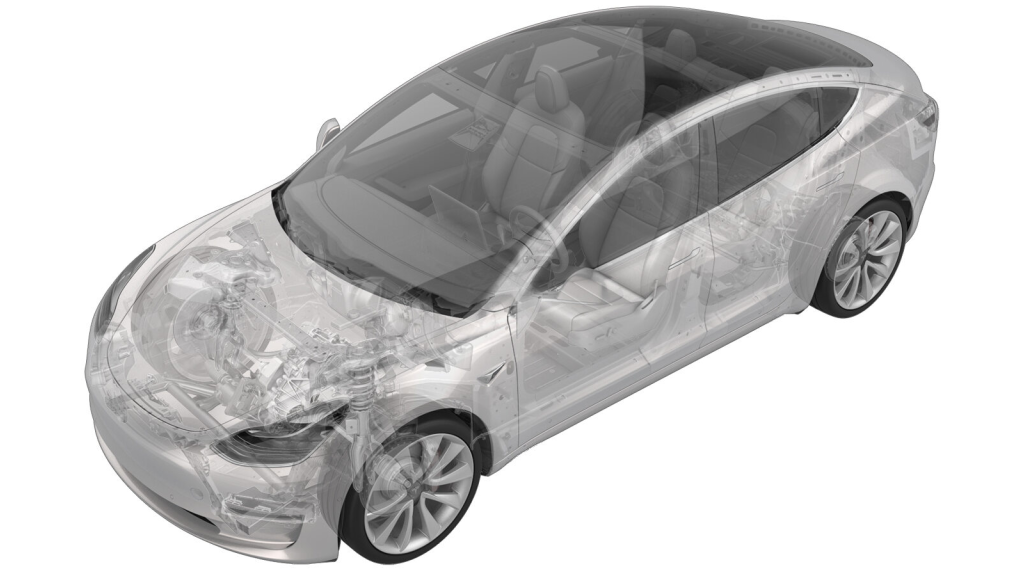Moteur – rail de siège – siège passager avant (retrait et remplacement)
 Code de correction
13013202 0.48
REMARQUE : À moins d’indications explicites contraires dans la procédure, le code de correction et le temps forfaitaire ci-dessus représentent tout le travail à être fait pour cette procédure, notamment les procédures connexes. N’appliquez pas plusieurs codes de correction à la fois, à moins qu’il vous soit explicitement indiqué de le faire.
REMARQUE : Consultez Temps forfaitaires pour en apprendre plus à propos des temps forfaitaires et de leur création. Vous pouvez transmettre par courriel vos commentaires relatifs aux valeurs des temps forfaitaires à l'adresse ServiceManualFeedback@tesla.com.
REMARQUE : Consultez Protection individuelle pour vous assurer de porter l’équipement de protection individuelle adéquat lors vous effectuez la procédure ci-dessous. Voir Précautions ergonomiques pour consulter les pratiques de travail sécuritaires et saines.
Code de correction
13013202 0.48
REMARQUE : À moins d’indications explicites contraires dans la procédure, le code de correction et le temps forfaitaire ci-dessus représentent tout le travail à être fait pour cette procédure, notamment les procédures connexes. N’appliquez pas plusieurs codes de correction à la fois, à moins qu’il vous soit explicitement indiqué de le faire.
REMARQUE : Consultez Temps forfaitaires pour en apprendre plus à propos des temps forfaitaires et de leur création. Vous pouvez transmettre par courriel vos commentaires relatifs aux valeurs des temps forfaitaires à l'adresse ServiceManualFeedback@tesla.com.
REMARQUE : Consultez Protection individuelle pour vous assurer de porter l’équipement de protection individuelle adéquat lors vous effectuez la procédure ci-dessous. Voir Précautions ergonomiques pour consulter les pratiques de travail sécuritaires et saines.
- 2024-10-15: Updated post-installation routines.
- 2023-12-08: Re-write the whole procedure according to the latest validation.
| Description | Valeur de couple | Outils recommandés | Réutiliser/remplacer | Remarques |
|---|---|---|---|---|
| Fixations du siège du passager avant (x4) |
 33.5 Nm (24.7 lbs-ft) |
|
Remplacer | Les boulons sont scellés |
| Boulon qui fixe l'ensemble du moteur de levage au bras de liaison arrière droit |
 18 Nm (13.3 lbs-ft) |
|
Remplacer | Les boulons sont scellés |
| Boulons (x2) qui fixent l'ensemble du rail latéral droit à l'ensemble du coussin du siège avant droit |
 23 Nm (17.0 lbs-ft) |
|
Réutiliser | Les boulons sont scellés |
Retirer
- Open all doors and lower all windows.
- Remove the RH instrument panel end cap. See Capuchons d’extrémité - tableau de bord - gauche (retirez et remplacez).
- Remove the RH middle A-pillar trim. See Garniture - montant avant - milieu - gauche (retirez et remplacez).
-
Release the bottom half of the RH front door seal.
- Remove the RH lower A-pillar trim. See Garniture - montant avant - inférieure - gauche (retirez et remplacez).
-
Use a clip prytool to release the RH front seat harness from the sill trim clips (x3).
-
Pull the RH front seat harness from under the RH front cabin carpet.
-
Move the RH front seat forward, and then remove and discard the RH front seat rear fasteners (x2).
TIpL'un ou plusieurs des outils suivants sont recommandés :
- Douille Torx Plus T45
- Clé à cliquet sans fil/Visseuse à percussion
- Clé à cliquet à tête flexible/clé dynamométrique à tête flexible
- Raise the RH front seat cushion to maximum height for access to the HV battery bolts at the RH front footwell and below the RH front seat.
-
Move the RH front seat backward, and then remove and discard the RH front seat front fasteners (x2).
TIpL'un ou plusieurs des outils suivants sont recommandés :
- Douille Torx Plus T45
- Clé à cliquet sans fil/Visseuse à percussion
- Clé à cliquet à tête flexible/clé dynamométrique à tête flexible
-
Tilt the seat backward to gain access to the underside of the LH front seat.
RemarqueTake care when moving the seat. Ensure the carpet is not damaged.
-
Remove and discard the bolt that attaches the lift motor assembly to the rear RH link.
TIpL'un ou plusieurs des outils suivants sont recommandés :
- Bit Torx T45 Stubby
- Clé à cliquet/Clé dynamométrique
- Rallonge de 3 po
- Clé à cliquet à tête flexible/clé dynamométrique à tête flexible
-
With assistance, remove the bolts (x2) that attach the RH side track assembly to the RH front seat cushion assembly.
TIpL'un ou plusieurs des outils suivants sont recommandés :
- Embout Torx T50
- Rallonge de 3 po
- Clé à cliquet à tête flexible/clé dynamométrique à tête flexible
- Clé à cliquet sans fil/Visseuse à percussion
-
Disconnect the front passenger seat track motor electrical connector.
-
Use a clip prytool to remove the harness clips (x2) from the RH front seat track motor.
-
Release the front passenger seat outer track from the track bridge assembly.
RemarquePry up on the bridge tack motor tab, and then slide the outer track away to release it.
-
Release the RH front seat track bridge assembly from the inner seat track.
RemarquePry up on the bridge tack motor tab, and then slide the seat track bridge assembly away to release it.
Installer
-
Install the RH front seat outer track onto the track bridge assembly.
RemarqueThe track motor cable is keyed square and must be aligned with the inner track. Turn the cable by hand to align as needed. Slide the track motor bridge into the inboard track till it is fully and securely seated.
-
Install the track motor bridge to the inner track.
RemarqueThe track motor cable is keyed square and must be aligned with the inboard track. Turn the cable by hand to align as needed. Slide the track motor bridge into the inboard track till it is fully and securely seated.
-
Connect the track motor electrical connector.
-
Install the harness clips (x2) to the RH front seat track motor.
-
With assistance, install the bolts (x2) that attach the RH side track assembly to the RH front seat cushion assembly.
 23 Nm (17.0 lbs-ft)TIpL'un ou plusieurs des outils suivants sont recommandés :
23 Nm (17.0 lbs-ft)TIpL'un ou plusieurs des outils suivants sont recommandés :- Embout Torx T50
- Rallonge de 3 po
- Clé à cliquet à tête flexible/clé dynamométrique à tête flexible
- Clé à cliquet sans fil/Visseuse à percussion
-
Install a new bolt that attaches the lift motor assembly to the rear RH link.
 18 Nm (13.3 lbs-ft)TIpL'un ou plusieurs des outils suivants sont recommandés :
18 Nm (13.3 lbs-ft)TIpL'un ou plusieurs des outils suivants sont recommandés :- Bit Torx T45 Stubby
- Clé à cliquet/Clé dynamométrique
- Rallonge de 3 po
- Clé à cliquet à tête flexible/clé dynamométrique à tête flexible
-
Reposition the RH front seat onto the RH front seat risers.
RemarqueTake care when moving the seat. Ensure the carpet is not damaged.
-
Secure the RH front seat harness under the RH front cabin carpet.
-
Install the RH front seat harness to the sill trim clips (x3).
-
Move the RH front seat forward, and then install new RH front seat rear fasteners (x2).
 33.5 Nm (24.7 lbs-ft)TIpL'un ou plusieurs des outils suivants sont recommandés :
33.5 Nm (24.7 lbs-ft)TIpL'un ou plusieurs des outils suivants sont recommandés :- Douille Torx Plus T45
- Clé à cliquet sans fil/Visseuse à percussion
- Clé à cliquet à tête flexible/clé dynamométrique à tête flexible
-
Move the RH front seat backward, and then install new RH front seat front fasteners (x2).
 33.5 Nm (24.7 lbs-ft)TIpL'un ou plusieurs des outils suivants sont recommandés :
33.5 Nm (24.7 lbs-ft)TIpL'un ou plusieurs des outils suivants sont recommandés :- Douille Torx Plus T45
- Clé à cliquet sans fil/Visseuse à percussion
- Clé à cliquet à tête flexible/clé dynamométrique à tête flexible
- Install the RH lower A-pillar trim. See Garniture - montant avant - inférieure - gauche (retirez et remplacez).
- Install the RH middle A-pillar trim. See Garniture - montant avant - milieu - gauche (retirez et remplacez).
- Install the RH instrument panel end cap. See Capuchons d’extrémité - tableau de bord - gauche (retirez et remplacez).
-
Install the RH front door seal along the lower A-pillar trim.
- Locally connect a laptop with Toolbox 3 to the vehicle. See Toolbox (connecter et déconnecter).
-
For NA vehicles only: On the
laptop, select the Actions tab, then search for "OCS". Run the PROC_OCS1P_SELF-CALIBRATIONvia Toolbox: (link)via Service Mode Plus: Safety & Restraints ➜ Seats ➜ OCS1P Self Capacitance Calibration
routine.
RemarqueVerify the seat is clear from any tooling or objects prior to calibration.
- On the laptop, select the Actions tab, then search for "Seat calibration". Run the PROC_VCRIGHT_SEAT-CALIBRATEvia Toolbox: (link)via Service Mode Plus: Low Voltage ➜ Seats ➜ Calibrate routine.
- Disconnect Toolbox and remove the laptop from the vehicle.
- Disable Service Mode. See Mode Entretien.
- Move the RH front seat to original position.
- Raise all windows and close all doors.